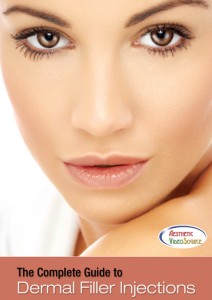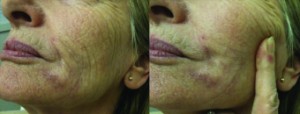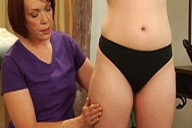Information for Dermal Filler Training – Risks of Dermal Fillers
0Tamara Griffiths, MD FRCP – Consultant Dermatologist on behalf of the British Association of Dermatologists explains about the risks of dermal fillers.
Loss of facial fat and volume loss is a hallmark of facial aging, which results in a gaunt, haggard appearance. Dermal fillers can be used effectively to replace volume and restore a more youthful facial shape, as well as fill lines and wrinkles. Common areas treated are the nasolabial folds (lines between the nostril and corner of the mouth), marionette lines (lines between the corners of the mouth and side of the chin), glabella (between the eyebrows) and lips. More sophisticated practitioners can treat the midface/cheeks, temples and periorbital areas (areas around the eyes). Products have been developed to treat areas on the body such as the breast and buttocks to enhance volume and shape, which require injection of large volumes of product. Other products are used superficially in the skin to reduce the thin, crepe-like appearance for example on the backs of the hands and neck/anterior chest. Fillers can also be used to improve cosmetic appearance in defects which involve underlying disease (e.g., linear morphea, facial atrophy associated with HIV treatment).
Risk of ALL injectable fillers: Injection-related risks common to all fillers includes superficial infection, bruising, bleeding, under/over-correction and poor outcome. A more serious risk for all injectable fillers is: vascular occlusion either through embolisation or compression. This can result in ulceration, tissue necrosis and scarring. In the case of retinal artery occlusion, permanent blindness can occur. Retinal blindness due to all types of dermal fillers (autologous, permanent, semi-permanent and non-permanent) has been documented in the medical literature. In the case of large vessel embolism, pulmonary embolism and death has been reported (buttock injection). Nerve damage is another potential risk. Injectable fillers can be classified as: autologous and non-autologous. The non-autologous category can be further classified as: permanent, semi-permanent and non-permanent (temporary).
Autologous fillers use the patient’s own tissue to fill the volume defect, for example: autologous fat transplant and autologous fibroblast transplant (donor graft harvested from patient’s own skin, cells cultured and reintroduced by injection). Autologous transplants carry little risk of allergic reaction or granuloma formation (which is an inflammatory response to a foreign body). There is also little risk of bio-film formation which is a chronic, low-grade bacterial encapsulation and colonization around the implant. However with fibroblast transplant, there is a risk for error with mismatched tissue donors. A patient’s skin cells are sent to an off-site laboratory to “grow” more cells in culture, and then sent back for injection into the same patient; samples can get confused with subsequent inherent infection and biohazard risk. The technique of autologous fat transplant is complex and there is higher risk for tissue damage and poor outcome. Fat tissue is harvested and prepared in real time on site, so there is little risk for donor mismatch. Both fat and fibroblast transplant carry risk of non-viability of transplanted cells and unsatisfactory results.
Non-autologous fillers are classified as permanent, semi-permanent and non-permanent (temporary). A potential risk for all of these is bio-film formation, as described above. The risks are mitigated with nonpermanent fillers as the product is eventually resorbed by the body, resorption can be accelerated in the case of hyaluronic acid fillers with the use of hyaluronidase injection. Sterile technique and a clinical environment will reduce risk of bio-film.
A theoretical benefit of permanent fillers is that further treatment may not be needed as the effect is long-lasting. In reality, however, facial ageing is a dynamic process and permanent change may with time become aesthetically displeasing. Permanent fillers carry a very poor record in terms of safety and are the most common type of filler associated with granuloma formation. This is a chronic, debilitating foreign body reaction also seen in diseases such as sarcoidosis and tuberculosis. Chronic nodules develop which may require treatment with systemic immunosuppressive agents (e.g. Prednisolone) and recurrent surgical removal.
Semi-permanent fillers are those that potentially have a long-lasting effect through stimulating an autologous response, such as increased collagen production. Examples are poly-lactic acid (Sculptra®) and hyaluronic acid plus calcium hydroxyapetite (Radiesse®). These products, by definition are not “inert” and have an intentional biologic activity, i.e. stimulatory effect on cells with tissue response. Those which contain components that are permanent (calcium hydroxyapetite) can cause granuloma formation. Some semi-permanent filler (poly-lactic acid) have been associated with nodule formation which may be dependent on injector technique. Benefit from semi-permanent filler may be disappointingly short-lived if the tissue response is poor.
Non-permanent or temporary fillers are unlikely to elicit granuloma formation; however, other allergic reactions can occur, such as delayed-type hypersensitivity with bovine collagen. Bluish discoloration due to an optical phenomenon called the Tyndall effect can occur if the product is injected in the wrongplane. It may be possible to mitigate some adverse events caused by hyaluronic acid filler with hyaluronidase. There is evidence documented in the literature that even hyaluronic acid fillers are not “inert” and stimulate a tissue response through fibroblast proliferation and collagen production, though they were not designed with this intention. Some temporary fillers contain local anaesthetic (lignacaine) which can cause anaphylaxis and death.
 It is important that health care professionals are properly educated and trained in dermal filler procedures. Dolores Kent, M.D., F.A.C.O.G. is a board-certified Harvard Medical School graduate, gynecologist and cosmetic surgeon, with over 20 years of experience. She trains practitioners on how to improve their dermal filler injection techniques. In her online dermal filler training video and DVD, she demonstrates how to perform popular cosmetic treatments using dermal fillers. She demonstrates how to use dermal fillers to achieve the cosmetic effects that clients are seeking.
It is important that health care professionals are properly educated and trained in dermal filler procedures. Dolores Kent, M.D., F.A.C.O.G. is a board-certified Harvard Medical School graduate, gynecologist and cosmetic surgeon, with over 20 years of experience. She trains practitioners on how to improve their dermal filler injection techniques. In her online dermal filler training video and DVD, she demonstrates how to perform popular cosmetic treatments using dermal fillers. She demonstrates how to use dermal fillers to achieve the cosmetic effects that clients are seeking.
Dolores Kent, M.D., F.A.C.O.G. demonstrates how to inject dermal fillers for the cosmetic treatment of horizontal forehead lines, glabellar frown lines, crow’s feet, tear trough, nasolabial folds, vertical lip lines, marionette lines, lip definition, lip augmentation, chin lines, mentalis, scars, and asymmetry. In this dermal filler training program, Dr. Kent also explains product options, dermal depth, contraindications and precautions, and injection guidelines. Dr. Kent demonstrates injections with popular soft tissue fillers on the market, including Restylane®, Juvéderm®, Radiesse®, and Hylaform®. She explains product options, product chemical composition (e.g., collagens, hyaluronic acid, and calcium hydroxylapatite), dermal depth (depending on product used), contraindications and precautions, and injection guidelines.
Click here to see a video sample of Dr. Kent’s techniques.
Testimonial: “Let me just say this up front, I love Aesthetic VideoSource… The videos are top notch, professionally done, and show you hands on techniques. They are the ‘go to’ source in the industry due to the quality of their products.” — Deb
To learn more:
Watch instant video streaming online or purchase a DVD.
The Complete Guide to Dermal Filler Injections DVD (2 Hrs. 29 Mins.) can be ordered online or by calling 801-282-2490 or toll free 1-800-414-2434 .

 Aesthetic VideoSource also has a 1 year unlimited online video streaming subscription to train yourself or train your staff. The subscription will give you unlimited online access to the library of online training videos for 1 year.
Aesthetic VideoSource also has a 1 year unlimited online video streaming subscription to train yourself or train your staff. The subscription will give you unlimited online access to the library of online training videos for 1 year.
![]() Download the new online Aesthetic VideoSource catalog – Educational online videos and DVDs for Spa, Beauty & Medical Professionals.
Download the new online Aesthetic VideoSource catalog – Educational online videos and DVDs for Spa, Beauty & Medical Professionals.
Contains public sector information licensed under the Open Government License v2.0.




